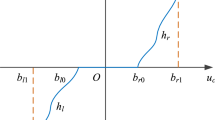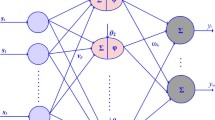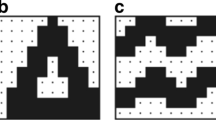Abstract
A TSK-type Hermite neural network (THNN) is studied in this paper. Since the output weights of the THNN use a functional-type form, it provides powerful representation, high learning performance and good generalization capability. Then, a Hermite-neural-network-based adaptive control (HNNAC) system which is composed of a neural controller and a robust compensator is proposed. The neural controller utilizes a THNN to online approximate an ideal controller, and the robust compensator is designed to eliminate the effect of the approximation error introduced by the neural controller upon the system stability. Moreover, a proportional-integral (PI)-type learning algorithm is derived to speed up the convergence of the tracking error. Finally, the proposed HNNAC system is applied to synchronize a coupled nonlinear chaotic system. In the simulation study, it shows that the proposed HNNAC system can achieve favorable synchronization performance without requiring a preliminary offline tuning.














Similar content being viewed by others
Explore related subjects
Discover the latest articles, news and stories from top researchers in related subjects.References
Slotine JJE, Li WP (1991) Applied nonlinear control. Prentice-Hall, Englewood Cliffs
Huang YJ, Kuo TC, Chang SH (2008) Adaptive sliding mode control for nonlinear systems with uncertain parameters. IEEE Trans Syst Man Cybern Pt B 38(2):534–539
Chen M, Jiang B, Jiang CS, Wu QX (2010) Robust control for a class of time-delay uncertain nonlinear systems based on sliding mode observer. Neural Comput Appl 19(7):945–951
Kung CC, Su KH (2005) Adaptive fuzzy position control for electrical servo drive via total sliding-mode technique. IEE Proc Electr Power Appl 152(6):1489–1502
Wai RJ, Tu CH (2007) Design of total sliding-mode-based genetic algorithm control for hybrid resonant-driven linear piezoelectric ceramic motor. IEEE Trans Power Electr 22(2):563–575
Wai RJ, Chuang KL, Lee JD (2010) On-line supervisory control design for maglev transportation system via total sliding-mode approach and particle swarm optimization. IEEE Trans Autom Control 55(7):1544–1559
Yeh MF (2007) Single-input CMAC control system. Neurocomputing 70(16):2638–2644
Cheng KH (2009) Auto-structuring fuzzy neural system for intelligent control. J Franklin Inst 346(3):267–288
Lin CM, Leng CH, Hsu CF, Chen CH (2009) Robust neural network control system design for linear ultrasonic motor. Neural Comput Appl 18(6):567–575
Chiu CH (2010) The design and implementation of a wheeled inverted pendulum using an adaptive output recurrent cerebellar model articulation controller. IEEE Trans Ind Electr 57(5):1814–1822
Chen CH, Hsu CF (2010) Recurrent wavelet neural backstepping controller design with a smooth compensator. Neural Comput Appl 19(7):1089–1100
Chen W, Jiao LC, Wu J (2012) Globally stable adaptive robust tracking control using RBF neural networks as feedforward compensators. Neural Comput Appl 21(2):351–363
Lin CT, Lee CSG (1996) Neural fuzzy systems: a neuro-fuzzy synergism to intelligent systems. Prentice-Hall, Englewood Cliffs
Lin CJ (2008) An efficient immune-based symbiotic particle swarm optimization learning algorithm for TSK-type neuro-fuzzy networks design. Fuzzy Sets Syst 159(21):2890–2909
Juang CF, Lo C (2008) Zero-order TSK-type fuzzy system learning using a two-phase swarm intelligence. Fuzzy Sets Syst 159(21):2910–2926
Mastorocostas P, Varsamis D, Hilas C, Mastorocostas C (2008) A generalized Takagi-Sugeno-Kang recurrent fuzzy-neural filter for adaptive noise cancellation. Neural Comput Appl 17(5):521–529
Engin SN, Kuvulmaz J, Ömurlü VE (2004) Fuzzy control of an ANFIS model representing a nonlinear liquid-level system. Neural Comput Appl 13(3):202–210
Lin FJ, Shen PH, Chou PH, Yang SL (2006) TSK-type recurrent fuzzy network for dsp-based permanent-magnet linear synchronous motor servo drive. IEE Proc Electr Power Appl 153(6):921–931
Chen CS (2010) TSK-type self-organizing recurrent-neural-fuzzy control of linear microstepping motor drives. IEEE Trans Power Electr 25(9):2253–2265
Hsu CF (2012) Intelligent tracking control of a DC motor driver using self-organizing TSK type fuzzy neural networks. Nonlinear Dyn 67(1):587–600
Lagerholm M, Peterson C, Braccini G, Edenbrandt L, Sornmo L (2000) Clustering ECG complexes using Hermite functions and self-organizing maps. IEEE Trans Biomed Eng 47(7):838–848
Linh TH, Osowski S, Stodolski M (2003) On-line heart beat recognition using Hermite polynomials and neuro-fuzzy network. IEEE Trans Instrument Meas 52(4):1224–1231
Jiang W, Kong SG (2007) Block-based neural networks for personalized ECG signal classification. Trans Neural Netw 18(6):1750–1761
Wang H, Gu H (2008) Chaotic synchronization in the presence of disturbances based on an orthogonal function neural network. Asian J Control 10(4):470–477
Lin FJ, Chen SY, Huang MS (2010) Tracking control of thrust active magnetic bearing system via Hermite polynomial-based recurrent neural network. IET Electr Power Appl 4(9):701–714
Lin CM, Hsu CF (2003) Neural network hybrid control for antilock braking systems. IEEE Trans Neural Netw 14(2):351–359
Lin CM, Hsu CF (2004) Supervisory recurrent fuzzy neural network control of wing rock for slender delta wings. IEEE Trans Fuzzy Syst 12(5):733–742
Lu J, Wu X, Han X, Lu J (2007) Adaptive feedback synchronization of a unified chaotic system. Phys Lett A 329(4):327–333
Chen HC, Chang JF, Yan JJ, Liao TL (2008) EP-based PID control design for chaotic synchronization with application in secure communication. Expert Syst Appl 34(2):1169–1177
Wang J, Deng B, Fei X (2008) Synchronization of chaotic neurons coupled with gap junction with time delays in external electrical stimulation. Chaos Solitons Fractals 35(3):512–518
Peng YF (2009) Robust intelligent sliding model control using recurrent cerebellar model articulation controller for uncertain nonlinear chaotic systems. Chaos Solitons Fractals 39(1):150–167
Chen YQ, Wang J, Chan WL, Tsang KM (2010) Chaos synchronization of coupled neurons under electrical stimulation via robust adaptive fuzzy control. Nonlinear Dyn 61(4):847–857
Lin TC, Chen MC, Roopaei M (2011) Synchronization of uncertain chaotic systems based on adaptive type-2 fuzzy sliding mode control. Eng Appl Artif Intell 24(1):39–49
Hsu CF, Tsai JZ, Chiu CJ (2012) Chaos synchronization of nonlinear gyros using self-learning PID control approach. Appl Soft Comput 12(1):430–439
Hsu CF, Chung CM, Lin CM, Hsu CY (2009) Adaptive CMAC neural control of chaotic systems with a PI-type learning algorithm. Expert Syst with Appl 36(9):11836–11843
Acknowledgments
The authors are grateful to the reviewers for their valuable comments. The authors appreciate the partial financial support from the National Science Council of Republic of China under grant NSC 100-2628-E-032-003.
Author information
Authors and Affiliations
Corresponding author
Rights and permissions
About this article
Cite this article
Hsu, CF. Hermite-neural-network-based adaptive control for a coupled nonlinear chaotic system. Neural Comput & Applic 22 (Suppl 1), 421–433 (2013). https://doi.org/10.1007/s00521-012-1154-4
Received:
Accepted:
Published:
Issue Date:
DOI: https://doi.org/10.1007/s00521-012-1154-4




